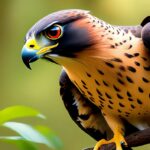Welcome to our article, “Fascinating Birds of Prey Facts: Unveiling the Majestic Hunters of the Skies.” In this exploration of avian marvels, we will delve into the captivating world of diurnal birds of prey, including falcons and hawks, unveiling their exceptional hunting skills and unravelling the mysteries behind their fascinating behaviors. Join us as we dive into the realm of these majestic creatures, uncovering their vital role in maintaining ecological balance and showcasing their awe-inspiring attributes.
Key Takeaways:
- Birds of prey, also known as raptors, are characterized by their hook-tipped beaks and sharp talons.
- There are over 500 species of birds of prey found worldwide, except in Antarctica, showcasing their wide distribution.
- Birds of prey primarily feed on other animals, including small mammals, birds, reptiles, and fish.
- Communication among birds of prey is achieved through vocalizations, serving purposes such as mate attraction and territorial defense.
- The conservation status of birds of prey varies, with habitat loss, pollution, and illegal hunting posing threats to certain species.
- Respectful observation of birds of prey in their natural habitats is crucial to minimize disturbance.
- Resources for further information on birds of prey can be found on Britannica and Just Fun Facts websites.
Birds of Prey Facts

Birds of prey, also known as raptors, are remarkable creatures with exceptional hunting abilities. They belong to two orders, Falconiformes and Strigiformes, and are characterized by their hook-tipped beaks and sharp talons. Let’s delve into some fascinating facts about these majestic hunters of the skies.
1. Incredible Diversity
Did you know that there are over 500 species of birds of prey found worldwide? This incredible diversity showcases their adaptability to various environments and habitats. From the powerful Golden Eagle to the agile Peregrine Falcon, each species has its own unique characteristics and hunting strategies.
2. Global Distribution
Birds of prey are found on every continent, except Antarctica. Their wide distribution demonstrates their ability to thrive in diverse ecosystems, ranging from dense forests to open grasslands. It’s truly astonishing how these birds have conquered the skies across the globe.
3. Predatory Prowess
As skilled hunters, birds of prey primarily feed on other animals. They display a wide range of hunting techniques, depending on the species. Some rely on their exceptional eyesight to spot prey from great heights, while others employ stealth and agility to surprise their targets. The way these birds strategize and execute their hunts is nothing short of awe-inspiring.
4. Varied Diet
Birds of prey have adaptable diets that mainly consist of small mammals, birds, reptiles, and even fish. Their talons play a crucial role in grasping and immobilizing their prey, while their beaks are adept at tearing the captured animals apart for consumption. This diverse diet allows them to maintain a balanced ecosystem by controlling populations and preventing the overabundance of certain species.
5. Vocal Communication
Communication among birds of prey primarily occurs through vocalizations, serving various purposes. They use vocalizations to attract mates, defend their territories, and communicate within family groups. These distinctive calls and vocalizations add to their captivating presence in the wild.
6. Conservation Challenges
Unfortunately, some species of birds of prey face threats to their survival due to habitat loss, pollution, and illegal hunting. Conservation efforts play a crucial role in preserving their populations and ensuring their habitats remain intact. By raising awareness about these remarkable creatures, we can contribute to their long-term protection.
7. Observing Birds of Prey
If you’re interested in observing birds of prey in their natural habitats, there are various locations worldwide where you can witness their impressive aerial displays and hunting behaviors. However, it’s essential to respect their space and observe from a safe distance, minimizing any disruption to their behaviors and habitats.
By unraveling these captivating facts about birds of prey, we gain a deeper appreciation for their important role in maintaining ecosystem balance and biodiversity. The world of raptors is truly awe-inspiring, showcasing their power, grace, and adaptability.
Birds of prey are fascinating creatures with unique behaviors and characteristics. If you want to discover fun facts about them, check out our page on birds of prey fun facts. Interested in observing birds of prey in Central Florida? Explore our comprehensive guide on birds of prey in Central Florida. For those curious about the diverse species found in Florida, our page on birds of prey in Florida provides valuable insights. Delve into the captivating world of these majestic hunters by clicking on the respective links.
Falcons: Fascinating Birds of Prey

Did you know that falcons are not only known for their incredible speed, but also possess a variety of unique characteristics? In this article, we will uncover some fascinating facts about these majestic birds of prey. So, buckle up and get ready to be amazed by the world of falcons.
1. Speed Demons:
Falcons are renowned for their remarkable speed, with the peregrine falcon holding the title for the fastest recorded animal ever. It has been observed diving for prey at speeds of up to 242 miles per hour[^1^]. Just imagine the adrenaline rush these birds experience while soaring through the skies at astonishing speeds!
2. Hunting Partners:
For thousands of years, falcons have been prized as hunting partners by humans. Falconry, an ancient practice dating back to ancient Mesopotamia, involves training falcons to assist with hunting[^1^]. The bond between falcons and their human counterparts is a testament to their intelligence and cooperative nature.
3. Lifelong Love:
Falcons are not only skilled hunters but also loyal partners. Once they find a mate, they stick together for life, building nests and raising their offspring as a team[^1^]. This monogamous behavior is a testament to the strong bonds formed within the falcon community.
4. Super Vision:
When it comes to vision, falcons are a cut above the rest. They possess incredibly sharp eyesight, capable of spotting prey from great distances. Additionally, falcons have the unique ability to see ultraviolet light, allowing them to detect markings on prey and navigate with precision[^1^]. Their keen eyesight is undoubtedly a crucial hunting advantage.
5. Varied Diet:
Falcons are not picky eaters! Their diet includes a wide range of prey, such as small mammals, birds, reptiles, and even insects[^1^]. Different species of falcons have adapted to various hunting techniques and prey types, enabling them to thrive in diverse environments[^2^]. This dietary flexibility contributes to their remarkable ability to survive in various habitats.
6. Near Extinction and Remarkable Recovery:
At one point, falcons faced the risk of extinction in North America due to habitat loss and the use of harmful pesticides like DDT. However, thanks to dedicated conservation efforts and the banning of these chemicals, falcon populations have made a remarkable recovery[^1^]. This success story reminds us of the importance of conservation in preserving these magnificent birds.
7. Not Just Speed:
While speed is one of their most well-known features, falcons possess additional remarkable traits as well. They exhibit impressive aerial agility, performing breathtaking maneuvers such as rapid turns and dives while in flight[^1^]. Their exceptional aerial abilities make them true acrobats of the sky.
8. Deadly Beaks:
Falcons’ sharp beaks serve multiple purposes. Not only do they use them for feeding, but they also wield them as weapons. With one swift strike, falcons are capable of capturing and breaking the necks of their prey, showcasing their predatory prowess[^1^]. Their deadly beaks are vital tools for survival in the wild.
Falcons are undoubtedly fascinating birds of prey, captivating our attention with their speed, hunting prowess, and unique behaviors. Understanding these incredible adaptations allows us to appreciate the vital role they play in maintaining ecological balance and enriching our natural world.
Key Takeaways:
- Falcons hold the record for being the fastest animals ever recorded, reaching speeds of up to 242 miles per hour[^1^].
- Falconry, an ancient practice that involves training falcons for hunting, dates back to ancient Mesopotamia[^1^].
- Falcons mate for life, with strong bonds between partners and a shared commitment to raising their offspring[^1^].
- Their exceptional vision allows falcons to detect prey from long distances and see in ultraviolet light[^1^].
- Falcons have a varied diet, including small mammals, birds, reptiles, and insects, allowing them to adapt to different environments[^2^].
- Conservation efforts and the banning of harmful pesticides have led to a remarkable recovery in falcon populations[^1^].
- Falcons possess remarkable agility and perform complex aerial maneuvers while in flight[^1^].
- Their sharp beaks serve as both feeding tools and weapons, enabling them to capture and break the necks of their prey with precision[^1^].
Sources:
– Smithsonian Magazine
– Animals.net
[ ]
Hawks: Fascinating Birds of Prey Facts
Hawks, the magnificent birds of prey, are known for their exceptional hunting skills and captivating characteristics. Let’s explore some intriguing facts about hawks and uncover the wonders of their habitat and distribution.
Description of Hawks
Hawks display a diverse range of sizes and plumage, making them truly captivating creatures. Their feathers come in various colors and patterns, with some species sporting solid-colored plumage. These majestic birds are equipped with sharp talons on their feet and a distinctive curved beak, perfectly designed for capturing and consuming their prey[^1^].
Fascinating Facts About Hawks
Hawks are renowned for their predatory prowess, and certain species stand out with fascinating attributes. One remarkable species is the Harris’s Hawk, commonly found in the southwestern United States. These birds possess exceptional abilities and thrive in diverse habitats[^1^].
Habitat of Hawks
Hawks are incredibly adaptable, making their homes in nearly every habitat across the globe, except for extremely polar regions. They can be found in tropical areas with high rainfall, as well as moderate climatic zones. Their impressive adaptability enables them to thrive in diverse ecosystems[^1^].
Distribution of Hawks
Hawks have established populations across most landmasses worldwide, making their presence truly global. From North America to Central and South America, these birds have successfully colonized various regions. However, they do not inhabit Antarctica and a few smaller islands[^1^].
Key Takeaways:
– Hawks possess diverse plumage, exhibiting an array of colors and patterns.
– The Harris’s Hawk is an exceptional species known for its remarkable abilities.
– Hawks are adaptable and can thrive in various habitats worldwide, except for polar regions.
– These birds have established populations across most continents, with a few exceptions.
To learn more captivating facts and information about hawks, you can refer to the following sources:
- Optics Mag: 27 Fascinating & Fun Hawk Facts You Never Knew
- Animals.net: Hawk – Description, Habitat, Image, Diet, and Interesting Facts
By delving into the intriguing world of hawks, we can enhance our appreciation for these extraordinary birds of prey and their essential role in maintaining ecological balance.
References:
[^1^]: Animals.net. Hawk – Description, Habitat, Image, Diet, and Interesting Facts
FAQ
Q1: What are diurnal birds of prey?
A1: Diurnal birds of prey are birds that primarily hunt during the day and have keen eyesight and aerial agility to capture their prey.
Q2: Can you provide some interesting facts about birds of prey?
A2: Certainly! Birds of prey, also known as raptors, exhibit exceptional hunting abilities, possess hooked beaks and sharp talons, and consume a diet consisting primarily of small mammals, birds, reptiles, and fish.
Q3: What are some fascinating facts about falcons?
A3: Falcons are known for their incredible speed, with Peregrine falcons being the fastest recorded animal. They also have monogamous mating behavior, possess ultraviolet vision, and have made a remarkable recovery from near extinction.
Q4: What characteristics make hawks unique?
A4: Hawks have a wide range of sizes and plumage, equipped with sharp talons and a distinctive curved beak. They are adaptable and can thrive in various habitats worldwide, except for extreme polar regions.
Q5: Where can I find more information about birds of prey?
A5: For additional captivating facts and information about birds of prey, you can visit credible sources such as Optics Mag and Animals.net for in-depth articles and insights into these majestic hunters of the skies.












